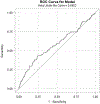Clinically Meaningful Body Mass Index Change Impacts Pediatric Nonalcoholic Fatty Liver Disease
- PMID: 35835225
- PMCID: PMC10008467
- DOI: 10.1016/j.jpeds.2022.07.004
Clinically Meaningful Body Mass Index Change Impacts Pediatric Nonalcoholic Fatty Liver Disease
Abstract
Objective: To investigate the prevalence and characteristics of children with nonalcoholic fatty liver disease (NAFLD) who reduce their body mass index (BMI) z-score (BMIz) by >.25, a goal in obesity medicine, and to determine the BMIz decrease needed for serum aminotransferase normalization.
Study design: This retrospective, single-center study included patients aged <18 years followed for NAFLD. Patients who had undergone weight loss surgery or had other reasons for weight loss/gain were excluded. Logistic regression was used to determine the odds of achieving a BMIz change of >-.25, as well as predictors of this outcome.
Results: Of the 784 children who met the study criteria (median age, 13 years; 66% male; 24% Hispanic), 541 had a lowest BMIz at >90 days following the baseline clinic visit. Of these children, 168 (31%) had a BMIz change of >-.25 from baseline over a median of 367 days (IQR, 201-678 days). Decreases in serum aminotransferase and lipid levels were seen in both groups (with and without a BMIz change of >-.25); however, these decreases were more pronounced in children who achieved a BMIz drop of >.25. Hemoglobin A1c concentration did not change in either group. Young age (OR, .861; 95% CI, .81-.92; P < .01) and non-Hispanic ethnicity (OR of non-Hispanic vs Hispanic, .61; 95% CI, .38-.97; P < .04) were predictors of a BMIz change >-.25. The BMIz decrease associated with normalization of serum alanine aminotransferase was .27.
Conclusions: A BMIz reduction of >.25 is associated with significant changes in serum aminotransferase levels. These findings can further guide the clinical management of children with NAFLD.
Keywords: NAFLD; children; obesity; weight.
Copyright © 2022 Elsevier Inc. All rights reserved.
Figures
Comment in
-
The influence of puberty on body mass index change and pediatric nonalcoholic fatty liver disease.J Pediatr. 2023 Aug;259:113466. doi: 10.1016/j.jpeds.2023.113466. Epub 2023 May 12. J Pediatr. 2023. PMID: 37179015 No abstract available.
References
-
- Dhaliwal J, Chavhan GB, Lurz E, Shalabi A, Yuen N, Williams B, et al. Hepatic steatosis is highly prevalent across the paediatric age spectrum, including in pre-school age children. Aliment Pharmacol Ther 2018;48:556–63. - PubMed
-
- Doycheva I, Issa D, Watt KD, Lopez R, Rifai G, Alkhouri N. Nonalcoholic steatohepatitis is the most rapidly increasing indication for liver transplantation in young adults in the United States. J Clin Gastroenterol 2018;52:339–46. - PubMed
-
- Vos MB, Abrams SH, Barlow SE, Caprio S, Daniels SR, Kohli R, et al. NASPGHAN clinical practice guideline for the diagnosis and treatment of nonalcoholic fatty liver disease in children: recommendations from the Expert Committee on NAFLD (ECON) and the North American Society of Pediatric Gastroenterology, Hepatology and Nutrition (NASP-GHAN). J Pediatr Gastroenterol Nutr 2017;64:319–34. - PMC - PubMed
-
- Sylvetsky AC, Welsh JA, Walsh SM, Vos MB. Action-oriented obesity counseling attains weight stabilization and improves liver enzymes among overweight and obese children and adolescents. Open J Pediatr 2012;2:236–43.
Publication types
MeSH terms
Substances
Grants and funding
LinkOut - more resources
Full Text Sources
Medical
Miscellaneous


